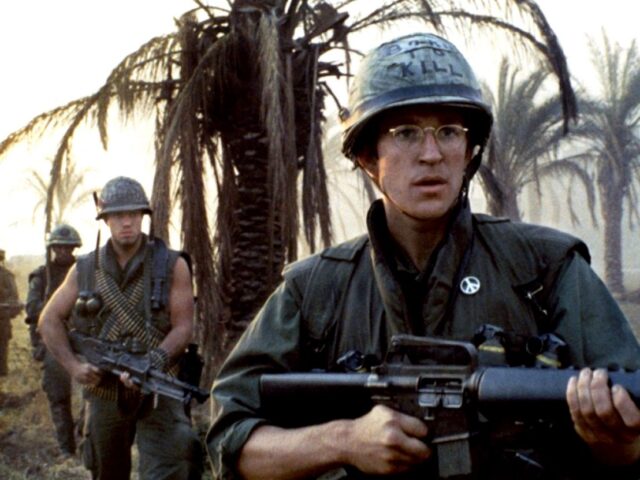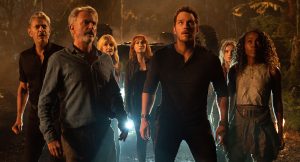
The post Monday Movie: Full Metal Jacket, by Kyle Anderson appeared first on Battleship Pretension.
Every Monday, we’ll highlight a piece of writing from our vaults. This review of Full Metal Jacket originally ran as part of Kyle Anderson’s Kubrick in Reverse series.
Stanley Kubrick’s penultimate film, 1987’s Full Metal Jacket, was a realistic slice of the life of a Marine in Vietnam, or at least realistic as far as Kubrick is concerned. Like all of the director’s work, Full Metal Jacket is meticulously crafted and full of indelible imagery. On the surface, the film is two disparate halves, one dealing with boot camp, the other with the war, but if viewed through a certain light, it’s as linear a narrative as Kubrick ever put forth. It takes a stance of being neither pro- nor anti-war and instead focuses on the Marines’ lives and what it takes to turn them into killers.
The opening shots of the film depict young men getting their heads shaved for boot camp. Each man has an empty, pensive look on his face as the barber roughly chops the hair from their heads. This is a moment that at first viewing can appear humorous, especially when the sequence is over and we get a shot of the discarded hair, but Kubrick is very deliberately showing us these boys at their very last moments of “innocence” before the Corps and the war change that. No extra attention is given to the stars of the film in this scene versus any of the other nameless characters and they are interspersed at random, showing both the perceived solidarity of the group and their utter interchangeability. In war, no one is special.
From there, the film shifts to the meat of the first half of the film: Boot Camp. Kubrick introduces us to Gunnery Sergeant Hartman, played brilliantly by R. Lee Ermey. He is the tougher-than-nails drill sergeant of the unit and spends the bulk of his screen time screaming. An already imposing force, Kubrick ups his menace by primarily shooting him with a wide angle lens and takes great care to ensure that he is in dead center of the frame, his head at the top. In his opening address to the new marines, he immediately sets himself up as mother, father, and god among them. He horribly berates people who step out of line or are in any way not up to scratch, all the while instilling in them the knowledge that they are to become killers.
We’re introduced to three new recruits in particular during this early scene, all of whom we will come to know exclusively through nicknames Sgt Hartman bestows upon them. The audience surrogate character is Pvt. Joker, played by Matthew Modine, and he is introduced via an ill-timed imitation of John Wayne during Hartman’s opening address. He remains a defiant figure, despite becoming a model marine as the film proceeds. Second, we see Pvt. Cowboy (Arliss Howard) who catches Hartman’s ire by being from Texas. Cowboy is Joker’s friend and cohort during boot camp. Finally, the audience is introduced to Pvt. Gomer Pyle, played by Vincent D’Onofrio in an astonishing performance, an overweight, mentally slow screw-up who Hartman immediately and perpetually picks on and browbeats.
A huge amount of screen time is spent watching the unit during basic training, learning how to be a marine and work together, and while this may seem like filler, it’s absolutely integral in understanding the path these boys take, from children to killers, without much in between. The film is, after all, about marines at war, not about the war itself. Joker and Cowboy show their mettle immediately, being both efficient and even exemplary in carrying out their tasks. Joker of course adds his own irreverence, but is nevertheless a model recruit. Standing in sharp contrast to this is Pvt. Pyle, who can’t seem to do anything right. Joker is even assigned to help Pyle with his various duties, and still Pyle fails, often causing the other recruits to suffer some form of punishment.
One evening, all of the young marines, including Joker, take turns beating Pyle with bars of soap wrapped in tube socks. Kubrick shoots this scene using very deliberate lighting. It is the dead of night and the only thing illuminating the scene is the light of the moon showing through the windows of the barracks. The result is almost ghostly as Pyle weeps in pain after the attack.
Finally, after everything jovial about him is gone, Pyle finds the one thing he is good at: shooting. He’s so good at shooting that Sgt. Hartman himself even congratulates him. But this isn’t the same young man who entered the Marine Corps those many weeks ago; he’s visibly different. He has lost all of his innocence. Another night, while Joker is on patrol, he sees Pyle sitting in the lavatory with his rifle. Pyle’s eyes convey nothing but rage and insanity and Joker cautiously tries to talk him down as Pyle locks and loads. Joker tells him he will be in a “world of shit,” if the Sgt hears them, to which Pyle famously responds, “I am in a world of shit.” Inevitably, Hartman does hear them and comes in angrily. Only for a moment, when he realizes the gravity of the situation, does he soften his approach, but before long he is back shouting and barking orders to which Pyle fires one shot point blank into Hartman’s chest before putting the barrel in his own mouth and pulling the trigger.
This is a very tense scene made even tenser by Kubrick’s direction. The bathroom is nearly as dark as the earlier barracks scene and the shadows cast on Pyle’s face heighten his demented face. In fact, D’Onofrio’s performance in this scene very closely mirrors Jack Nicholson’s from The Shining made seven years earlier. When Pyle fires on Hartman, it suddenly becomes slow-motion, the man flying backwards as blood and viscera explodes from his chest. This very like the bullet hits made famous by Sam Peckinpah and later John Woo, but unlike those two filmmakers, Kubrick does not use it for exploitation or sensationalism. It must be remembered that while Pvt Joker is not necessarily the focus of the scene, his is at all times the point of view we are getting. At the moment Hartman is hit, the reality of the situation, and indeed the reality of war and death itself, hit him like a ton of bricks. He has not even left boot camp and he’s already seen the worst.
The film then shifts to Vietnam where Pvt. Joker is now a corporal and a combat correspondent with the “Stars and Stripes” paper. He is now even more irreverent than he was before, often clashing with his superior at the paper. He is always lamenting not seeing more action and even tells his sidekick/photographer Rafterman he’s not cut out for it. His helmet is inscribed with the words “Born to Kill” on it, but he wears buttons with the peace sign. He doesn’t know what he is; he’s been trained to kill, but he’s yet to actualize it.
Throughout this portion of the film, Joker and Rafterman come in contact with a number of other marines who actually are killers. In a helicopter, they encounter a gunner who happily, gleefully machine guns Vietnamese people, women and children alike. They meet up with Joker’s old pal Cowboy’s unit where the meet the likes of 8 Ball and Animal Mother, who kill like they literally were born to do it. Animal Mother specifically has very little respect for Joker and his lack of killing experience. This is a world where proving oneself on the battlefield is the only thing that matters.
The culmination of Joker’s story is also the most Kubrickian sequence. On a reckon mission, the unit is hit by a sniper, by all accounts acting alone, and things begin to go pear-shaped. 8 Ball and eventually Cowboy are hit as the unit braves the ruined neighborhood searching for the sniper. Kubrick keeps the camera in nice and tight, staying right in the thick of the action and tracking with them as they run, however on various occasions, the camera is suddenly far away in a bird’s eye view. It zooms in and we know before the characters do that we’re seeing what the sniper sees. Then with a quick cut, we’re back with the guys right as the next bullet is fired.
Finally, they catch up to the sniper and it’s Rafterman who fires the shot, proudly joining the ranks of his fellow marines. But the sniper, who is not who they were expecting, is not quite dead. After some goading from Animal Mother, Joker delivers the coup de gras. He was trained to be a killer, he’s been surrounded by death, and now, at last, he’s ceased to be a witness or a chronicler, he’s an active participant. For one of the most politically divisive wars in history, the film about it ends on neither side of the argument. Full Metal Jacket and Stanley Kubrick do not force us to take sides. Like Joker, we’re merely witnesses.
The post Monday Movie: Full Metal Jacket, by Kyle Anderson first appeared on Battleship Pretension.
The post Monday Movie: Full Metal Jacket, by Kyle Anderson appeared first on Battleship Pretension.



